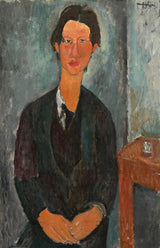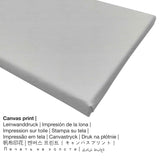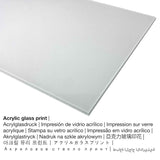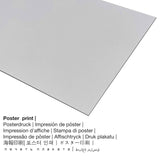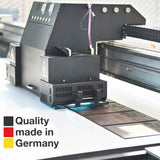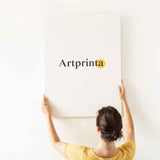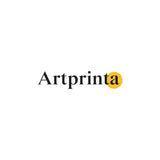Amedeo Modigliani, 1917 - Chaim Soutine - mbipụta nka mara mma
Ụtụ gụnyere. Mbupu gbakọrọ na ndenye ọpụpụ.
Additional information as provided from National Gallery of Art (© Nwebiisinka - nke National Gallery of Art - Nnukwu osisi nke Art)
Born in 1884 to an aristocratic family in Livorno, Italy, Amedeo Modigliani settled in the Montmartre neighborhood of Paris in 1906 and began making paintings influenced by both the mood of Picasso's Blue period and the pictorial structure of late Cézanne. In 1909 he met Constantin Brancusi and began to focus on sculpture; the thin features and references to African art in the series of stone heads of 1909–1914 clearly reflect Brancusi's influence.
As both painter and sculptor Modigliani concentrated on portraiture. Though he abandoned sculpture in late 1913 or early 1914 to return to painting, the long necks and attenuated features of his sculptures continue in his later painted portraits. Modigliani is also renowned for a series of languorous nudes, some of which he exhibited in 1918 at the Galerie Berthe Weill in Paris; the exhibition was closed by the police on the grounds of obscenity. Modigliani died of tubercular meningitis, aggravated by drugs and alcohol, in a Paris hospital in 1920.
The 11th child of a Russian Jewish tailor, Chaim Soutine (1894–1943) was rescued from poverty and abuse by a rabbi who recognized his talent and sent him to art school—first in Minsk, then in Vilna. Soutine arrived in Paris at the age of 17 in 1911–1912 and met Modigliani in Montparnasse in about 1914. They developed a close friendship, and Modigliani painted Soutine's portrait several times. Soutine's unruly, spontaneous manner of painting was alien to his Italian friend, who, to describe his own state of drunkenness, once quipped, "Everything dances around me as in a landscape by Soutine." The elegant Modigliani felt protective of the uncouth Soutine, 10 years his junior. In 1916 Modigliani introduced his friend to his dealer, Leopold Zborowski, and urged him to handle Soutine's work, which he began to do. Shortly before Modigliani died, he told Zborowski, "Don't worry, I'm leaving you Soutine."
While many of Modigliani's portraits are either stylized and impersonal—with eyes often left blank—or almost caricatural, this painting seems to be both particular and sympathetic. Soutine sits with tumbling hair and ill-matched clothes, his hands placed awkwardly in his lap, his nose spreading across his face as he stares out of the frame. The half-closed eyes, one slightly higher than the other, might suggest Soutine's despair and hopelessness, attitudes with which Modigliani could identify as a poor artist in Paris. Modigliani's treatment of Soutine may also reflect the special place that Soutine had won in the older artist's affections.
Nkọwapụta nka nka akpọrọ Chaim Soutine
N’afọ 1917 Amedeo Modigliani kere nka nka. Nke 100 year-old artwork has the following following dimensions: 91,7 x 59,7 cm e were kwa ihe-ọcha tee ya mmanụ na kwaaji. Enwere ike ilele ihe nka na n'ime National Gallery of Art's digital art collection, which is the museum of the US-American nation that preserves, collects, exhibits, and fosters an understanding of works of art. We are delighted to state that this artpiece, which is part of the public domain is being included with courtesy of National Gallery of Art, Washington.Ebe E Si Nweta nke ihe osise:. Na mgbakwunye na nke a, nhazi nke mmepụta dijitalụ bụ Eserese na oke nke 2: 3, nke pụtara na ogologo bụ 33% mkpụmkpụ karịa obosara. Amedeo Modigliani was a painter, sculptor, whose artistic style was mainly Expressionism. The Italian painter was born in the year 1884 in Livorno, Livorno province, Tuscany, Italy and passed away at the age of 36 n'afọ 1920.
Akụrụngwa ị nwere ike isi na ya nweta
The product dropdown list provides you with the opportunity to select the material and sizeaccording to your personal preferences. The following sizes and materials are the options we offer you for individualization:
- Mbipụta enyo acrylic: The acrylic glass print, often described as a fine art print on plexiglass, will convert your favorite original into gorgeous home decoration. The work of art will be printed with state-of-the-art UV print machines. The major upside of a plexiglass print is that contrasts and painting details will be exposed because of the very fine tonal gradation. The plexiglass with real glass coating protects your custom fine art print against light and heat for many decades.
- Mbipụta kwaaji: A canvas print is a printed canvas stretched on a wood frame. A printed canvas generates a cosy, comfortable ambience. How can I hang a canvas on my wall? The great advantage of canvas prints is that they are relatively low in weight. This means, it is easy to hang your Canvas print without any wall-mounts. A canvas print is suited for all types of walls.
- Mbipụta akwụkwọ mmado (ihe kwaaji): The poster print is a printed sheet of canvas paper with a granular surface finish, that resembles the actual artwork. Please bear in mind, that depending on the absolute size of the poster print we add a white margin of around 2-6cm round about the painting in order to facilitate the framing with a custom frame.
- Mbipụta nke aluminom: An Aluminium Dibond print is a print material with a true depth effect - for a modern look and a non-reflective surface structure. A direct Aluminium Dibond Print is your best start to replicas on aluminum. For the Print On Aluminum Dibond, we print your chosen work of art onto the surface of the aluminum. The white & bright parts of the artwork shimmer with a silk gloss but without glare. The colors are luminous and bright in the highest definition, the details appear clear and crisp.
Nchịkọta nkenke nke onye na-ese ihe
| aha: | Amedeo Modigliani |
| Aha nka ndị ọzọ: | Modigliani Amedeo Clemente, Modiljani Amedeo, Modigliani, Modilʹi︠a︡ni Amedeo, מודילאני אמאדאו, a. modigliani, Modigliani A., Mūdilyānī Amīdivū, amadeo modigliani, Modigliani Amadeo, Mo-ti-liang-ni, Amedeo Modigliani, מודיליאני אמדיאו, Modigliani Amedeo |
| okike nke onye nka: | nwoke |
| Nationality: | Italian |
| Ọrụ: | onye ese, ọkpụkpụ |
| Obodo obibi: | Italy |
| Nkewa onye nka: | omenkà nke oge a |
| Ụdị nka: | Nkwupụta |
| Oge ndu: | 36 afọ |
| Afọ ọmụmụ: | 1884 |
| Ebe amụrụ onye: | Livorno, mpaghara Livorno, Tuscany, Italy |
| Afọ ọnwụ: | 1920 |
| Nwụrụ na (ebe): | Paris, Ile-de-France, France |
Data ndabere na ọrụ nka pụrụ iche
| Aha nke eserese ahụ: | "Chaim Soutine" |
| Nhazi nka: | sere |
| Otu sara mbara: | nkà nke oge a |
| oge: | 20th narị afọ |
| Afọ nka: | 1917 |
| Afọ nka: | 100 afọ |
| Usoro izizi: | mmanụ na kwaaji |
| Akụkụ izizi (ọrụ nka): | 91,7 x 59,7 cm |
| Ụlọ ihe ngosi nka: | Nnukwu osisi nke Art |
| Ebe ngosi nka: | Washington DC, Njikota Obodo Amerika |
| website: | Nnukwu osisi nke Art |
| Licensedị ikike: | ngalaba ọha |
| Site n'aka: | National Gallery of Art, Washington |
Product ọmụma
| Nkewa bipụta: | nka nka |
| Usoro mmeghari: | dijitalụ mmeputakwa |
| Usoro mmepụta: | mbipụta dijitalụ |
| Nlụpụta: | German mmepụta |
| Stockdị ngwaahịa: | a na-achọ |
| A na-atụ aro iji ngwaahịa eme ihe: | foto mgbidi, ihe ndozi mgbidi |
| Nhazi nke ihe nka: | nhazi ihe osise |
| Oke akụkụ onyonyo: | 2: 3 ogologo ruo obosara |
| Akụkụ onyonyo pụtara: | ogologo bụ 33% mkpụmkpụ karịa obosara |
| Ihe mmeputakwa dị: | Mpempe akwụkwọ, akwụkwọ mmado (akwụkwọ akpa), mbipụta enyo acrylic (nwere ezigbo mkpuchi iko), mbipụta ọla (aluminium dibbond) |
| Ọdịiche dị n'okirikiri akwa akwa akwa (akwa akwa): | 20x30cm - 8x12", 40x60cm - 16x24", 60x90cm - 24x35", 80x120cm - 31x47", 100x150cm - 39x59" |
| Mpempe iko acrylic (nwere ezigbo mkpuchi iko) nha: | 20x30cm - 8x12", 40x60cm - 16x24", 60x90cm - 24x35", 80x120cm - 31x47", 100x150cm - 39x59" |
| Nhọrọ nke mbipụta akwụkwọ mmado (akwụkwọ kwaaji): | 40x60cm - 16x24", 60x90cm - 24x35", 80x120cm - 31x47" |
| Mbipụta aluminom: | 20x30cm - 8x12", 40x60cm - 16x24", 60x90cm - 24x35", 80x120cm - 31x47" |
| ụba: | agunyeghi |
Ederede iwu dị mkpa: We try the best we can in order to depict the products as clearly as possible and to exhibit them visually on the product detail pages. Nevertheless, the colors of the print materials, as well as the printing might diverge somehwat from the presentation on your monitor. Depending on the screen settings and the quality of the surface, not all colors can be printed one hundret percent realistically. Given that all our art prints are printed and processed manually, there may as well be slight differences in the motif's exact position and the size.
© nwebiisinka, Artprinta.com

